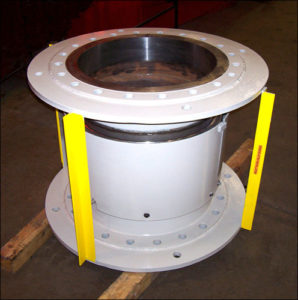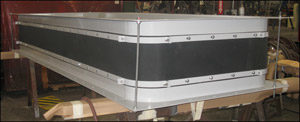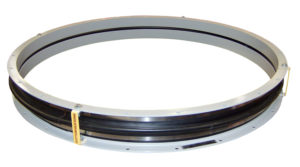Understanding Material Selection: Metallic, Fabric, and Rubber
Understanding the various types of expansion joints is the first step toward selecting the right solution for your system. The primary categories are metallic, fabric, and rubber, each offering unique benefits and being suited for different operating conditions. These components ensure the lifespan of your infrastructure.
Common Types of Metallic Expansion Joints
Metallic expansion joints, also known as bellows, are flexible elements used in piping systems to absorb movement caused by thermal expansion, vibration, and pressure fluctuations.
These are often made from thin-walled metal cylinders, such as stainless steel, that are formed into a series of convolutions or bellows. The shape of the bellows allows them to flex and compress, accommodating axial, lateral, and angular movement.
- Single Expansion Joints – Designed to absorb axial movement and vibration in a straight run of pipe.
- Hinged Expansion Joints – Accommodate angular rotation in a single plane, using a hinge to prevent axial and lateral movement.
- Gimbal Expansion Joints – Allow for angular rotation in any plane, making them perfect for complex directional changes.
- Universal Expansion Joints – Designed with two bellows joined by a center pipe to handle large amounts of lateral movement.
- Elbow Pressure Balanced Expansion Joints – Deployed at a directional change in a pipeline to absorb movement while eliminating pressure thrust, eliminating the need for main anchors.
- In-line Pressure Balanced Expansion Joints – Absorb axial movement in a straight run of pipe while balancing pressure forces without the need for main anchors.
- Externally Pressurized Expansion Joints – Feature a design where the bellows are externally pressurized, preventing column instability (squirm).
- Toroidal Expansion Joints – Designed with smooth, omega-shaped bellows that offer high durability and high pressure capacity. Typically used in heat exchangers.
- Thick Wall Expansion Joints – Engineered with extra-thick bellows to withstand high temperature and pressure applications.
- Slip-type Expansion Joints – Designed with a sliding piston or sleeve design to absorb large amounts of axial movement.
- Rectangular Metallic Expansion Joints – Designed to handle movement in rectangular or square ductwork.
- Refractory Lined Expansion Joints – Designed with an internal ceramic or cement lining to protect against high temperatures and abrasive media.
Fabric Expansion Joints
Fabric pipe expansion joints are often used in ducts that carry hot gases at low pressures. The primary design parameters are the temperatures and flow rates of the gases, as well as the amount and abrasiveness of solids suspended in the gases. Layers of different fabrics can be combined to accommodate the varying temperatures and pressures within the system. The fabric belt may need to be replaced periodically.
Rubber Expansion Joints
Rubber pipe expansion joints are often used to compensate for minor misalignment and offset. The design is chemical and abrasion resistant and accommodates higher pressures than the standard metal expansion joints and eliminates sediment buildup. They feature an integrally flanged design, eliminating the need for gaskets, and are designed to absorb noise, vibration, and shock. This single, wide arch, spool-type rubber expansion joint is provided with hot-dipped galvanized retaining rings.
Looking for the right expansion joint for your project? Download our catalog.





